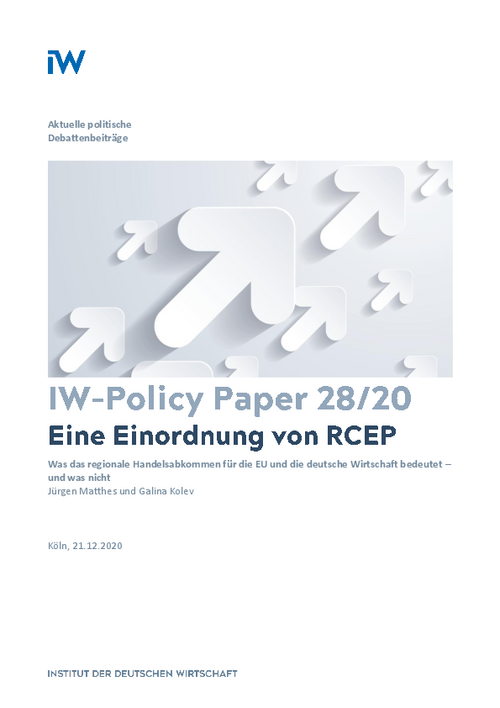RCEP is relevant for Europe, but it is over-estimated in some respects. Compared with EU trade agreements, trade liberalisation remains low. This is mainly because, already before, about five sixths of intraregional trade took place between partners under bilateral free trade agreements (FTAs), so that tariffs reduction is low overall.

RCEP: What the Trade Agreement Means for the EU and the German Economy
IW Policy Paper

RCEP is relevant for Europe, but it is over-estimated in some respects. Compared with EU trade agreements, trade liberalisation remains low. This is mainly because, already before, about five sixths of intraregional trade took place between partners under bilateral free trade agreements (FTAs), so that tariffs reduction is low overall.
Only Japan, South Korea and China will reduce tariffs to a significant extent, but with transition periods of up to two decades. In services trade, apart from selective new openings, there is primarily a lock-in of existing liberalisation in order to raise reliability and transparency. Economically very relevant, however, is the consolidation of the many overlapping bilateral FTAs in the region and, above all, the simplification of rules of origin, which are quite liberal with respect to third countries. This step reduces trade bureaucracy, especially for SMEs, and will further strengthen cross-border value chains in the region.
The RCEP region is important for Germany. It accounts for 13.0 per cent of merchandise exports and 17.3 per cent of imports in 2019. Although China dominates, the other RCEP members stand for 5.8 per cent of exports and 7.3 per cent of imports. RCEP likely has little direct economic impact on Europe. A model-based study estimates a tiny positive effect of 0.06 per cent of GDP in 2030. Moderate negative trade diversion effects at the expense of European exporters (probably mainly in China) are compensated by positive effects of higher growth in the RCEP region.
China's role is overrated. RCEP did not come about under the leadership of Beijing, but of the ASEAN community. Nor has China spread its standards, since RCEP does little here either. China can participate largely because of its economic power. However, it had to agree to tariff reductions with Japan and South Korea, which it had long shied away from. RCEP was worth this price to the Chinese leadership, because it facilitates strategic self-marketing. China presents itself as a liberaliser and opponent of protectionism (of the US) and can point out that the US is not part of RCEP – and neither is its other rival India. In addition to this geopolitically relevant success, China will invest more in the region (also within the frame-work of the Belt and Road Initiative) and will expand its importance in regional value chains. In doing so, it is increasingly using some ASEAN countries, such as Vietnam, as an export platform, presumably also to circumvent EU and US trade barriers.
RCEP is not embarrassing for the EU. In fact, the spirit of RCEP – trade liberalisation and rules-based trade despite political conflicts – also corresponds to the EU's goals. Moreover, the EU is already present in the region with several FTAs or is negotiating them. An agreement with ASEAN has not been reached mainly due to high EU requirements on environ-mental and human rights standards. However, in the future, the EU must pay even more attention to the Indo-Pacific region in general. Joining RCEP does not seem advisable in this respect because of its low standards and because the EU would have to dismantle trade barriers on imports from China. Instead, the EU should consider to join a more elaborated version of CPTTP – together with the US and the United Kingdom. Within this framework, market- and value-based standards can be set on a plurilateral basis. The agreement could set precedents for new WTO rules and would be open to China, but only if Beijing accepted these standards.

Jürgen Matthes / Galina Kolev: Eine Einordnung von RCEP – Was das regionale Handelsabkommen für die EU und die deutsche Wirtschaft bedeutet – und was nicht
IW Policy Paper

More on the topic
![[Translate to English:] Das Gebäude des Weißen Hauses in Washington, D.C. in den Vereinigten Staaten von Amerika. [Translate to English:] Das Gebäude des Weißen Hauses in Washington, D.C. in den Vereinigten Staaten von Amerika.](/fileadmin/_processed_/c/1/csm_GettyImages-2161499385_White_House_Editorial_884306add8.jpg)
Trump or Harris or ...? What Europe must prepare for
A few months before the presidential election in the USA, Donald Trump has a good chance of being re-elected. On the Democratic side, the incumbent president has withdrawn his candidacy after a long period of hesitation, while Vice President Kamala Harris is ...
IW
Competitive pressure from China for German companies
A firm survey conducted in March/April 2024 as part of the IW-Zukunftspanel among around 900 German companies from the manufacturing and industrial services sectors shows that around 350 of the companies surveyed have Chinese competitors in their markets.
IW